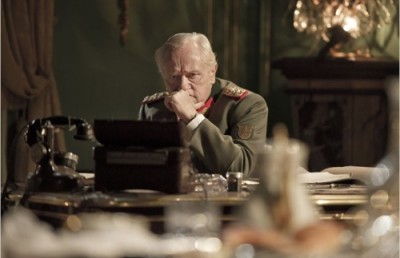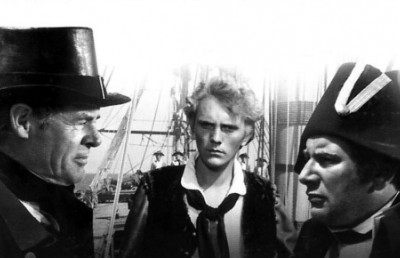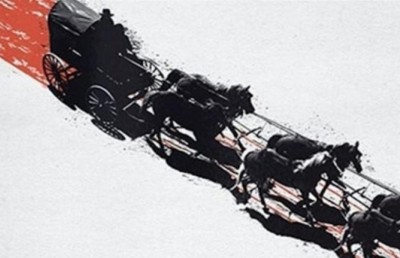The Crisis of National Identity and Nation: A Comparative Analysis of La Grand Illusion and Bashu, The Little Stranger
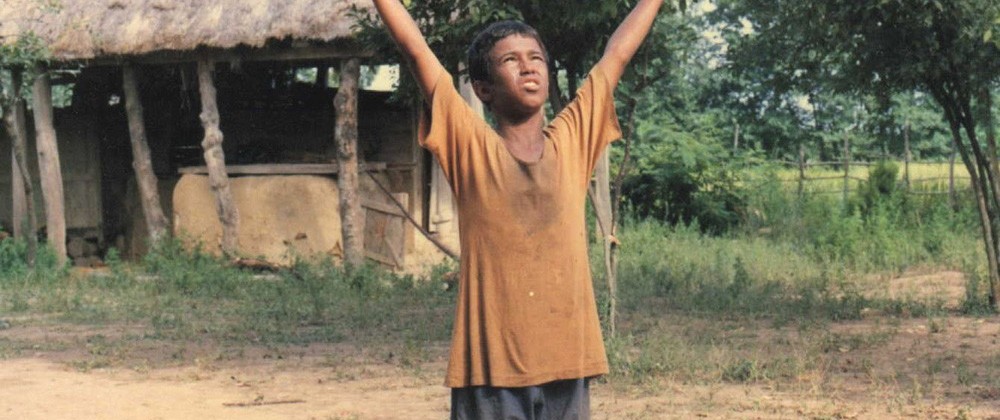
The power of cinema lies in its ability to break through barriers—be they cultural, political, linguistic, religious, ethnic or otherwise. Films that draw attention to the problematic nature of these divisions can reframe such broad concepts as national identity and the nation by articulating the complexities of these ideological constructs through the universal language of cinema. La Grand Illusion (Jean Renoir, 1937) and Bashu, The Little Stranger (Bahram Beizai, 1986), both produced within political climates of war, are important films to compare and contrast when considering how these concepts are addressed in cinema. Both films present characters confronting questions of identity and national belonging, which effectively serve to problematize the very concept of the nation. These characters are identified by ethnic, religious, and linguistic differences that underscore the multiplicities that construct but also threaten the idea of the nation as a strong and unified entity. Though set during different historical contexts, La Grand Illusion and Bashu, The Little Stranger commonly suggest—through narratives steeped in poetic realism—that borders can be drawn but are uneasily upheld.
Perhaps the most important factor that connects La Grand Illusion with Bashu, The Little Stranger is the time periods in which the films are set and the historical contexts within which they were produced and released. La Grand Illusion is set in a POW camp in Germany during World War I and was produced and released in the interwar period. Bashu, The Little Stranger is set and filmed in the northern countryside of Iran during the Iran-Iraq war; however, the film was not released until after the war ended in 1989 due to government censorship. Despite its critical success, La Grand Illusion similarly faced censorship in Belgium, Italy and Germany, presumably due to anti-war themes that defied the political rhetoric of the era of its release in the lead up to World War II.
Framing the films’ narratives within political contexts of war effectively lays the groundwork for central questions that propel the protagonists on their journeys: Will Maréchal and Rosenthal escape Germany and will an orphaned Bashu escape the psychological trauma of war? These central questions are complicated further by barriers of language, religion and ethnicity, which the characters must overcome in order to reclaim their rightful places within their respective nation states. Fellow Frenchmen Maréchal and Rosenthal are divided by ethnicity and religion (Rosenthal being Jewish and of Eastern European descent) while Bashu is an Arabic speaking, dark-skinned Iranian from Southern Iran who turns to Na’i, a Gilaki speaking woman, for help once he winds up in the north, orphaned and with nowhere else to go.
Language barriers and racial prejudices inevitably unfold as characters in both films are forced to defend national identities that are overshadowed by difference:
Renoir labors to negotiate differences and to strengthen the prisoners’ mutual trust and sense of group belonging, despite the linguistic, national, regional, class, and ethno-religious differences that are forever threatening to fracture this community (Scullion, 65).
We notice this early on in the film, when the French prisoners dine together complaining about prison food and Rosenthal offers to share his gourmet delicacies with his fellow inmates. Here, Rosenthal’s upper class status overrides his ethnic and religious differences, allowing him to form a bond with his prison-mates and effectively break down ethnic and religious divides. As one soldier remarks, “I’ve never eaten so well in my life… I’m getting used to Rosenthal’s kindness” (Jean Renoir, La Grand Illusion, 1937).
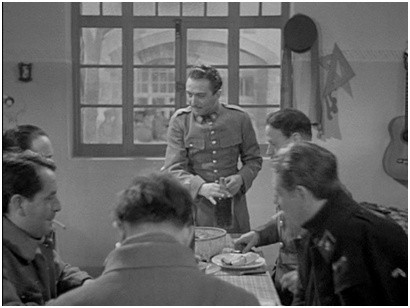
Later on in the film, however, as tensions between Rosenthal and Maréchal escalate when they attempt to flee Germany and are weighed down by injury and fatigue, the solidarity established previously disintegrates as Maréchal proclaims, “You’re a dead weight, a ball and chain. I could never stomach Jews!” (Jean Renoir, La Grande Illusion, 1937).
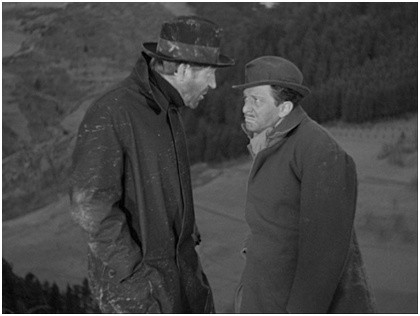
It is only when they meet Elsa, a widowed single mother who takes them in, that Rosenthal’s ethnic difference serves to effectively reconcile the two men. Unable to communicate in German with Elsa, Maréchal relies on Rosenthal to translate; thus, reinstating their sense of fraternity despite Rosenthal’s non-French lineage.
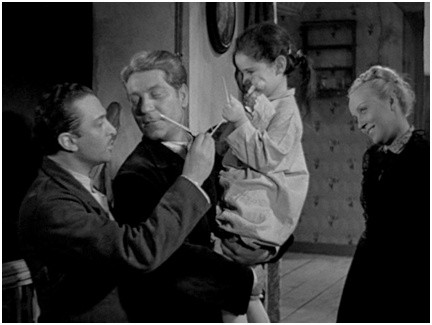
In Bashu, The Little Stranger, ethnic and linguistic differences are also impediments for Bashu, which initially prevent him from integrating into his adopted community. Na’i, confused by his dark skin and inability to speak Gilaki, resigns herself to teach him her language and to try and wash off his darkness, which underscores problems inherent to notions of national identity and cultural difference that are central to the film’s narrative: “the film’s inclusion of ethnic minorities in its frame of vision helps to problematize the myth of a linguistically, racially and culturally unified Iran” (Rahimieh 239). Furthermore, in the context of the Iran-Iraq war, ethnic and linguistic disparities that were underscored in the film effectively challenged the idea of Iran as being a strong and unified nation state, perhaps explaining why the film was censored when it was first released in 1986.
As the narrative unfolds, Bashu’s differences remain problematic for villagers who fail to accept him as part of their community, while Na’i eventually overcomes her prejudices and embraces him as her own child. This occurs when Bashu proclaims in Arabic that he is lost in what he believes may be a foreign land, which later impels Na’i to try and communicate with him in Gilaki. The warmth of their exchange affirms her commitment to him as a surrogate mother, despite the villagers’ continued mistrust and disapproval of him. Na’i, played by Susan Taslimi, one of the first leading women in post-revolutionary Iranian cinema, becomes the vehicle through which director Beizai probes questions of identity and cultural difference: “Women in Baizai’s films occupy a central position as narrative agents, and in this film Nai’ works the fields, takes care of her children, and, in accepting Bashu, defies tradition and the authority of family and village elders” (Naficy, 552).
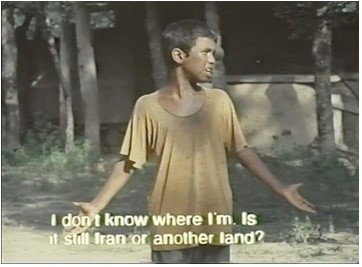
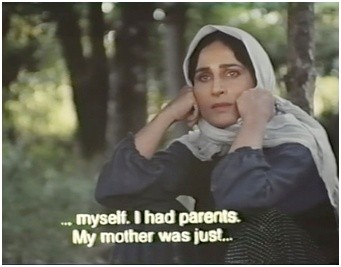
Despite his earlier setbacks, Bashu begins to gain the trust of others in the community once he demonstrates his ability to read, write and speak Farsi, Iran’s official language, confirming that he is indeed Iranian and thus, one of them. Na’i uses Bashu’s literacy as a means to assert her authority by having him write a letter to her absent husband, whom we later discover has been working in the war torn south. In the letter, she proclaims that Bashu is her son and that she will not abandon him, effectively going against what he has asked her to do, which illustrates that “in this instance, Persian both facilitates the already complicated communications between Na’i and Bashu and legitimizes Bashu’s position within the core of Na’i’s family” (Rahimieh, 249).
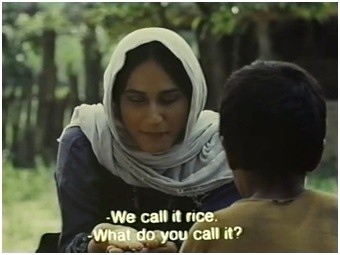
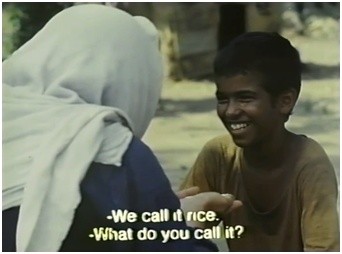
Having characters break through ethnic, religious, and linguistic barriers proves to be an effective means for these films to illustrate the complexities of national identity and the nation, which, as mentioned earlier, impacted the films’ dissemination. That being said, both films were eventually widely seen despite censorship efforts aimed at minimizing their distribution and have become important milestones in French and Iranian cinema. The films’ visual styles, which employ poetic realism to draw audiences into their narratives and further deconstruct questions of nationalism, renders La Grand Illusion and Bashu, The Little Stranger among the most influential films of their respective national cinemas and arguably in the history of cinema.
Poetic realism uses visual metaphor as a means to explore character, theme, and narrative with subtlety and depth. In both films, rural settings serve as metaphorical backdrops, which function as places of refuge and rehabilitation for Maréchal, Rosenthal and Bashu. The fertility of the land mirrors Elsa and Na’i who, as mothers, become integral to the rehabilitation process by acting upon their maternal instincts and becoming caregivers for the strangers they take in. Roxanne Varzi describes the metaphorical significance of the Caspian region of northern Iran as “a space of return to a mother’s womb, a place of women and children and of rehabilitation, a feminized space of escape from the male nation at war” (Varzi, 4). The rural fields of south Germany can be characterized under similar terms or, as James Kerans describes, “the alternate to the fortress…which offers plain food and love” (Kerans, 11).
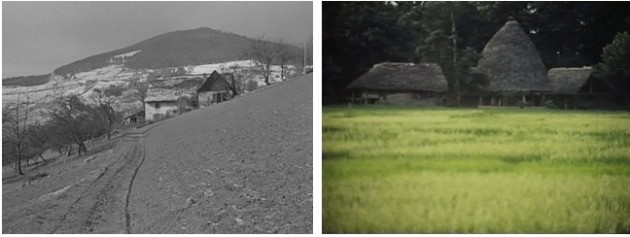
Further examples of poetic realism include elements of nature, which are used in both films to convey symbolic meaning. The geranium that Rauffenstein, a German aristocrat officer, methodically looks after symbolizes the continuation of life and hope amidst the misery and despair of the prison. Rauffenstein, whose class connects him to the French aristocrat officer Boeldieu, cuts the geranium after witnessing Boeldieu’s death, which symbolizes not only the loss of their friendship and effectively hope, but also the death of their class, the aristocracy.
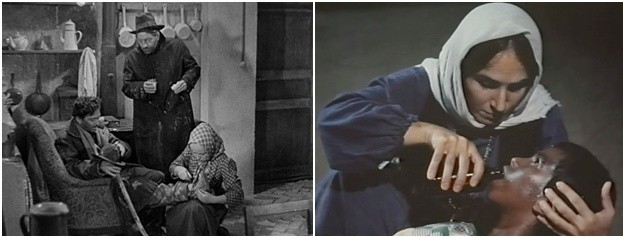
Later on, when Maréchal tends to Elsa’s cow, he reveals his longing to see France and Germany reunite, addressing the cow as if he were a friend. Here, the cow represents the common man who falls victim to larger political struggles, as echoed by Maréchal who states, “You’re a cow from Württemberg and I’m a working man from Paris, but we can still be pals! You’re a poor cow and I’m a poor soldier. We each do our best” (Jean Renoir, La Grande Illusion, 1937).
In Bashu, The Little Stranger, fire and water function metaphorically throughout the film. For example, when Bashu flees the war, fire is used to illustrate the ravaged land he escapes from and then later recurs when Na’i is gravely ill. In both the former and latter instances, fire is used to symbolize the looming threat of death brought on by war and illness.
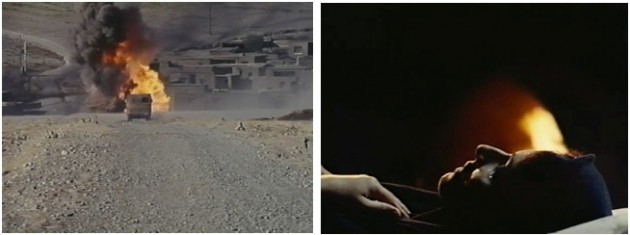
Alternately, water serves to symbolize rebirth and renewal as is seen when Na’i decides to give Bashu a bath in the river hoping to wash away his dark skin, only to realize his color will not change. In this scene, she begins to accept him for who he is and embrace him as one of her own children, symbollically giving birth to him in the process.
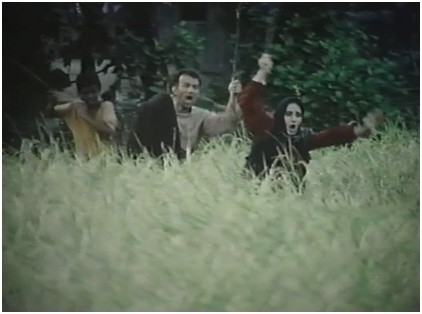
Finally, animals are present throughout the film functioning metaphorically on various occasions. When Bashu sees birds flying in the sky above him, he likens them with war planes and is panicked by the possibility of being under attack. The presence of other animals, such as the dog and wild boar, serve as symbols of fidelity and foreign invasion. In the final scene of the film, when Na’i’s husband finally returns home, Bashu arrives at the scene to find them arguing about Na’i’s decision to take him in. We hear a dog barking, which alludes to Na’i’s husband’s failure to have faith in his wife’s judgement and ultimately, his unloyalty to the family, having abandoned them for the war front. Later in the scene, after Bashu and the husband make amends, Na’i detects wild boar in the rice fields and together, the family runs after them, symbolizing the unification of Iran in the face of foreign aggression.
Though produced in different historical, cultural and political contexts, La Grand Illusion and Bashu, The Little Stranger, commonly serve to illustrate how cinema can effectively transcend notions of racial, cultural, linguistic and religious difference while breaking down barriers that obscure universal notions of love, camaraderie and the shared struggles of humanity. By reframing concepts of national identity and the nation within larger conceptions of humanism and universalism, these films demonstrate that commonality can indeed be found in worlds that are seemingly far apart. Through the subtle yet effective cinematic language of poetic realism, both films offer powerful commentaries on life, death, war and peace and engage viewers in thoughtful reflection on the meaning of these concepts and the unique power of film to transform and articulate them.
Works Cited
James Kerans. “La Grande Illusion.” Film Quarterly Vol. 14, No. 2 (Winter, 1960): 10- 17.
Rosemarie Scullion. “Lessons for the Neoliberal Age: Cinema and Social Solidarity from Jean Renoir to Jean-Pierre and Luc Dardenne.” Substance #133 Vol 34, No. 1 (2014): 63-81.
Nasrin Rahimieh. “Marking Gender and Difference in the Myth of the Nation: A Post-Revolutionary Iranian Film.” The New Iranian Cinema: Politics Representation and Identity. Ed. Richard Tapper. London: I.B. Tauris & Co Ltd, 2002. 238-252. Print.
Hamid Naficy. “Iranian Cinema Under the Islamic Republic.” American Anthropologist, New Series, Vol. 97, No. 3 (Sep., 1995): 548-558.
Roxanne Varzi. “Iran’s Pieta: Motherhood, Sacrifice and Film in the Aftermath of the Iran-Iraq War.” Feminist Review Issue 88 (2008): 86-99.



